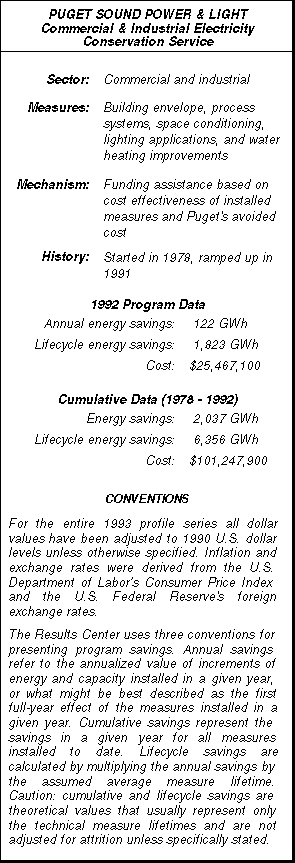IIEC Recent News
Puget Power, Commercial/Industrial Energy Management (commercial/industrial), Profile #74
EXECUTIVE SUMMARY Puget Sound Power and Light’s Commercial and Industrial Electricity Conservation Service (CIECS) has been available since late 1978 and as such was one of the first DSM programs of its kind to be offered to the commercial sector. Puget’s philosophy behind the service is based on the utility’s strong commitment to the installation of cost-effective conservation measures in commercial and industrial facilities, in new and existing applications in its service territory to control load growth and to provide valuable customer services.
Puget Sound Power and Light’s Commercial and Industrial Electricity Conservation Service (CIECS) has been available since late 1978 and as such was one of the first DSM programs of its kind to be offered to the commercial sector. Puget’s philosophy behind the service is based on the utility’s strong commitment to the installation of cost-effective conservation measures in commercial and industrial facilities, in new and existing applications in its service territory to control load growth and to provide valuable customer services.
The conservation service originated out of a small staff of professional engineers who had the technical expertise necessary to analyze commercial and industrial facilities and the communication skills needed to discuss their results with customers. Their analyses emphasized a whole facility approach that addressed all facets of electricity use. The program’s intent was and continues to be to focus on and promote tried-and-proven technologies that provide cost-effective energy savings.
Beginning in 1993 Puget began to screen measures for installation using the total resource cost for cost effectiveness. Measures that pass this criteria are then eligible for incentives based on the utility’s avoided cost, a value that reflects the lifetime and characteristics of the specific measures installed. For the most part the utility has steered clear of prescriptive rebates for specific products, favoring a case-by-case customized approach for each project with typical incentive payments equal to 60-80% of customers’ total installation costs, a level significantly exceeding more traditional prescriptive rebate programs for commercial and industrial customers. Typically the utility pays about half of its avoided cost. For instance according to the utility in 1992 the commercial and industrial programs cost an average of 3.3¢/kWh while its avoided cost for measures with an average measure life of 15 years was 6.5¢/kWh.
Like all of Puget Power’s DSM programs, the CIECS program was dramatically ramped up in 1991 when Puget was given the opportunity to reap shareholder incentives for meeting aggressive DSM targets. As this profile describes, Puget succeeded in beating its overall energy savings target of 16 aMW, but also in controlling its direct administrative costs for which it was additionally rewarded. In 1991 CIECS capacity savings increased to 6.3 aMW from the 1990 level of 3.1 aMW. In 1992 the programs’ capacity savings grew to 13.9 aMW, and the 122 GWh that were saved through energy conservation in participating commercial and industrial facilities in 1992 fulfilled 50% of the utility’s entire conservation savings. For 1994, Puget expects CIECS to contribute an even greater proportion of savings, fully 65% of its overall energy savings.
[CLICK HERE TO DOWNLOAD THE ENTIRE 24 PAGE PROFILE IN PDF FILE FORMAT]
This profile was produced by

